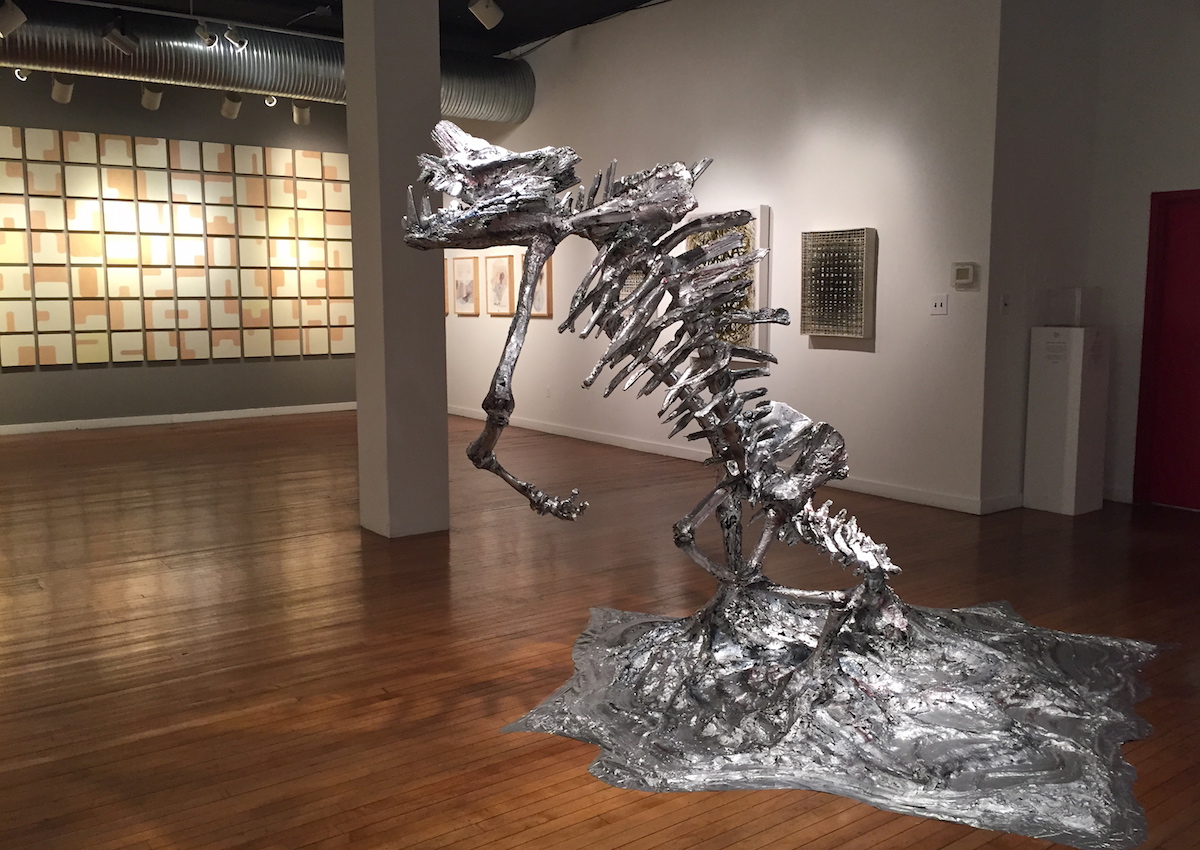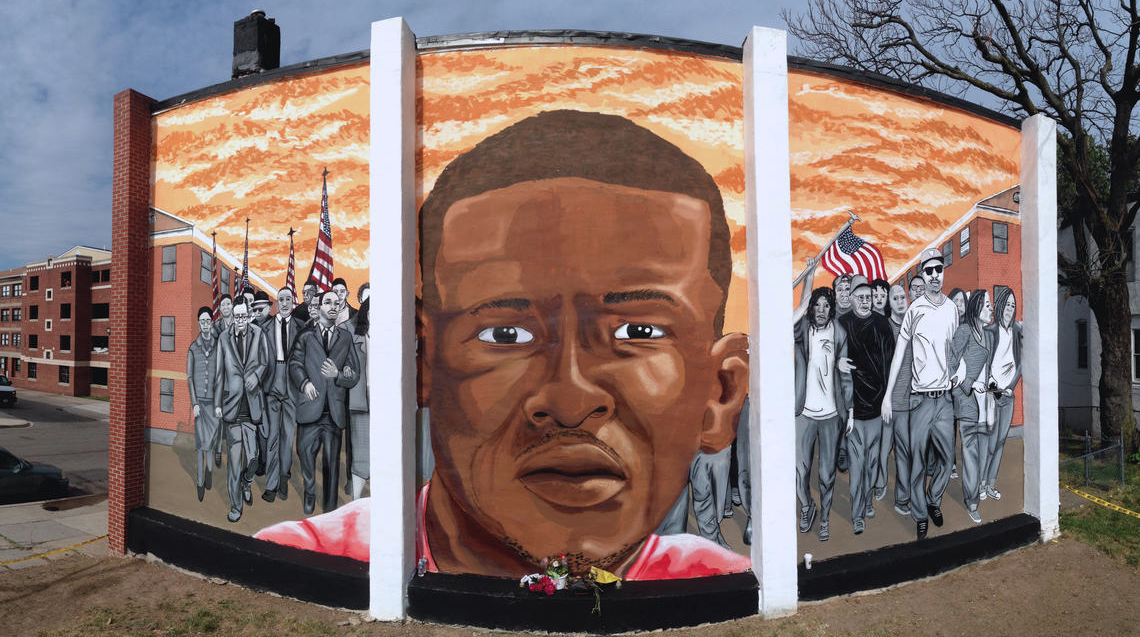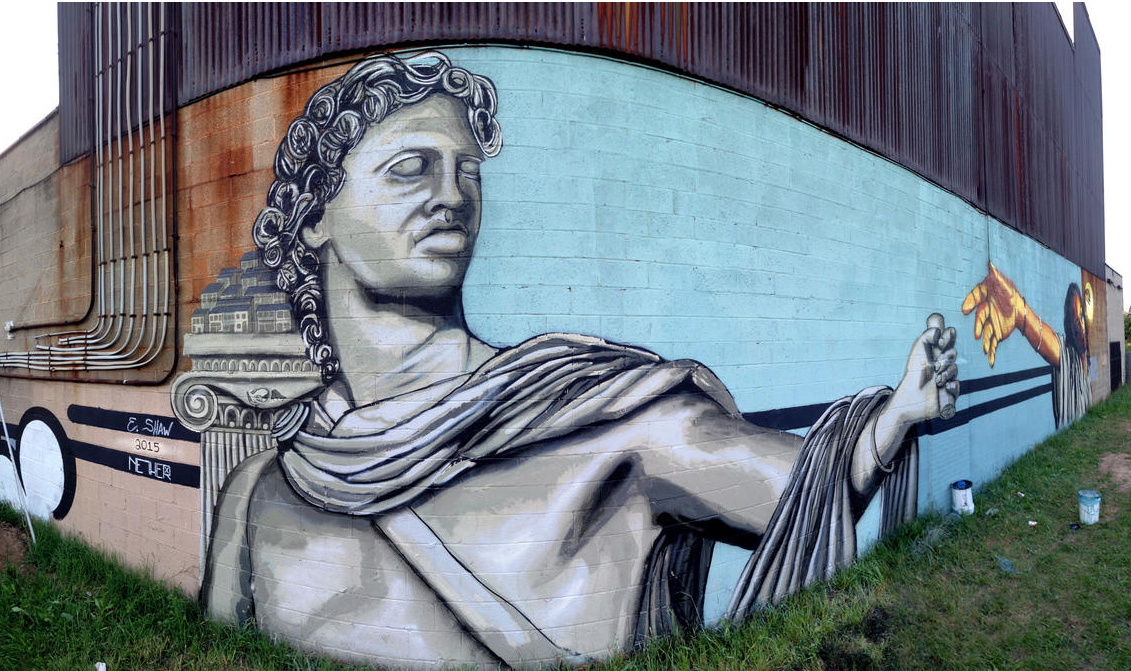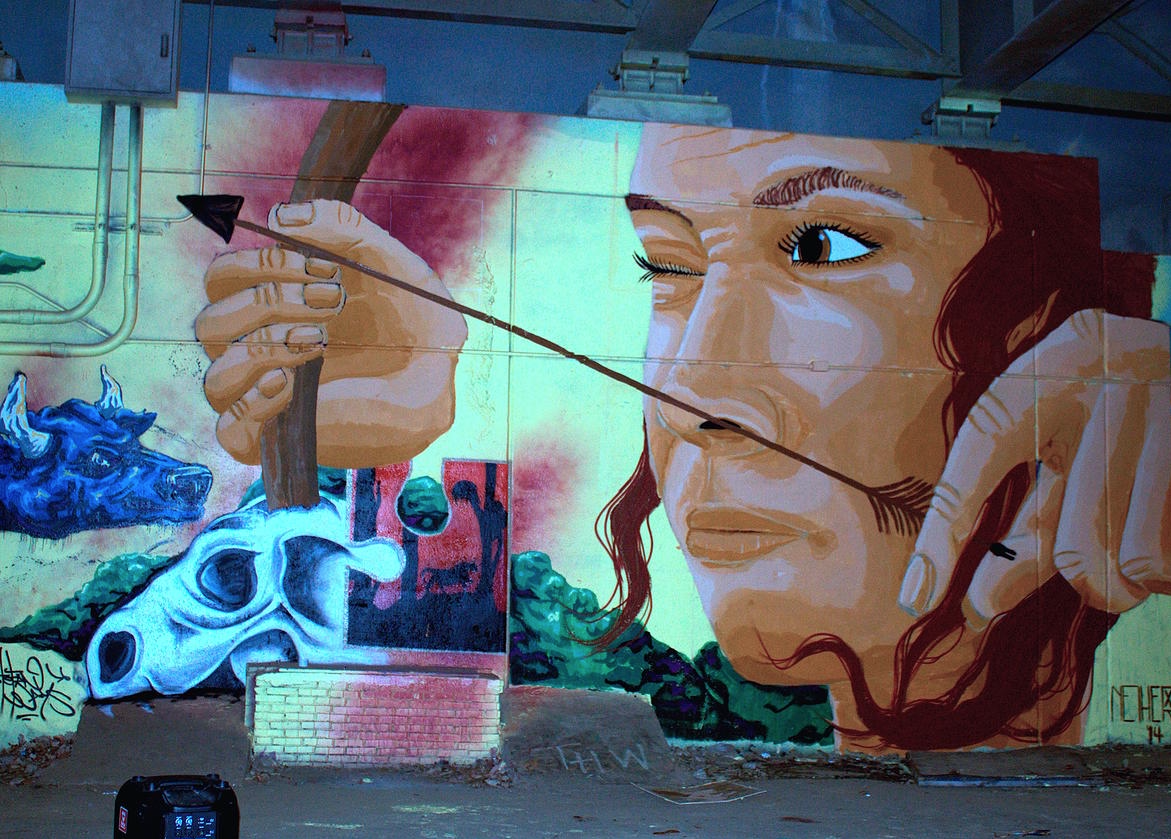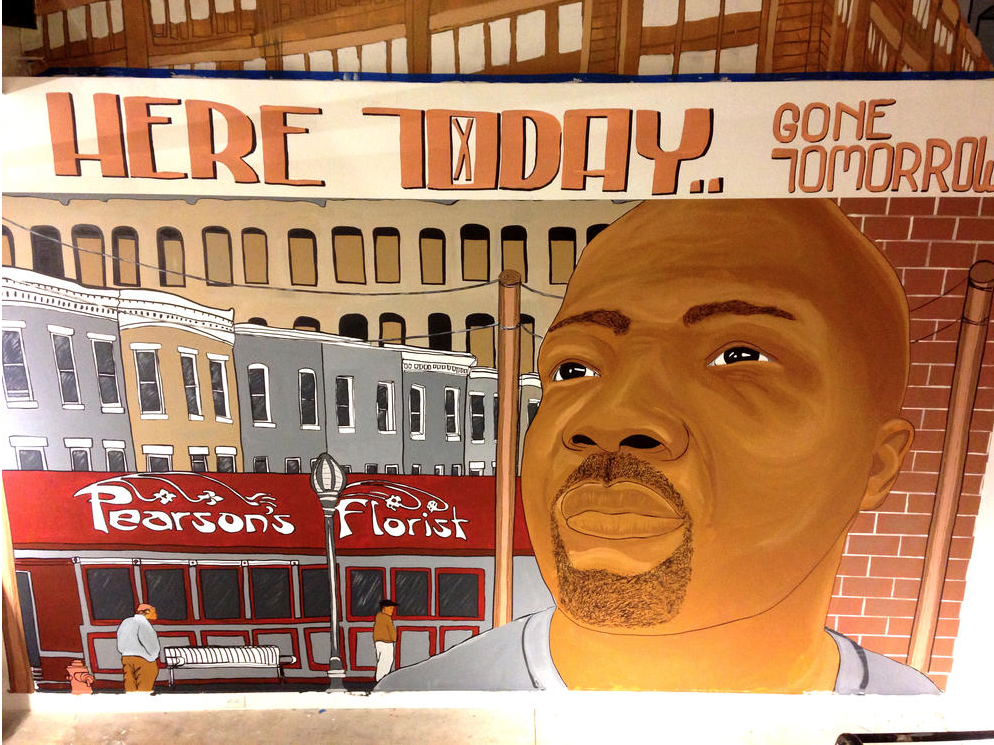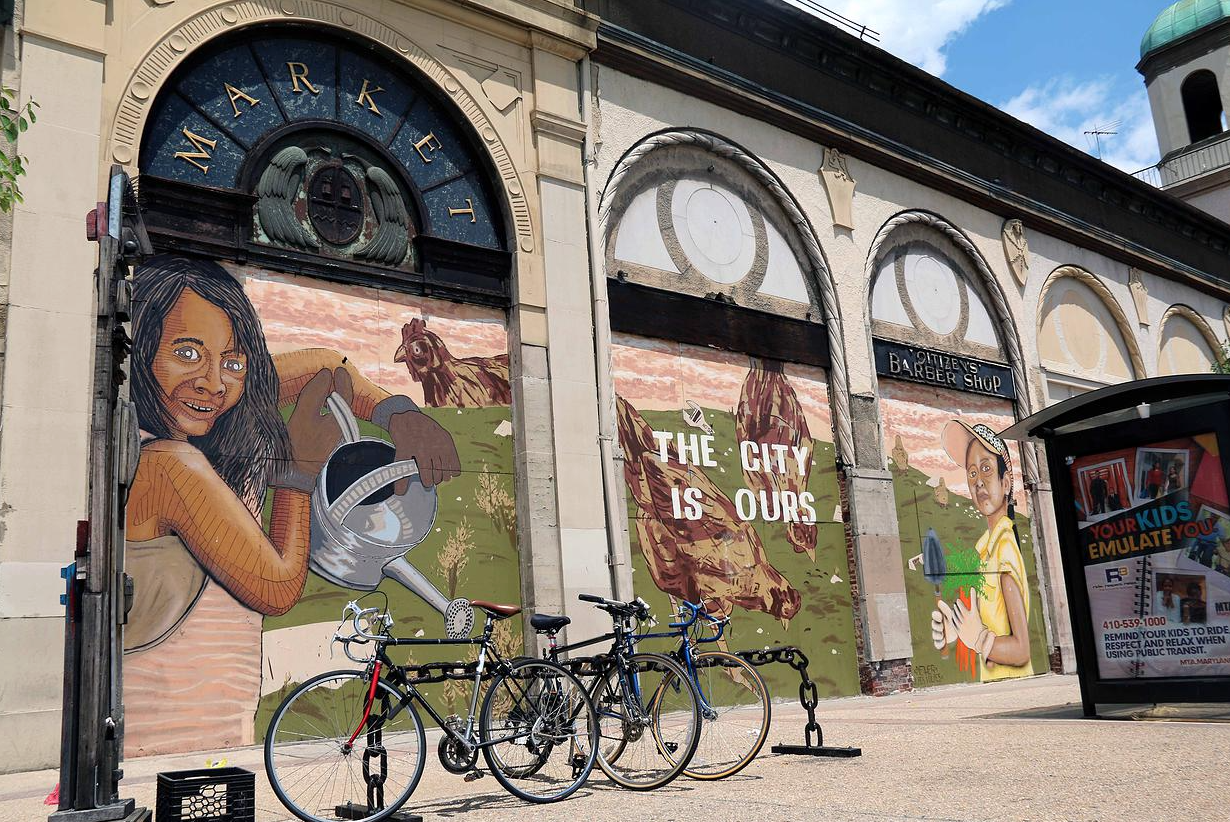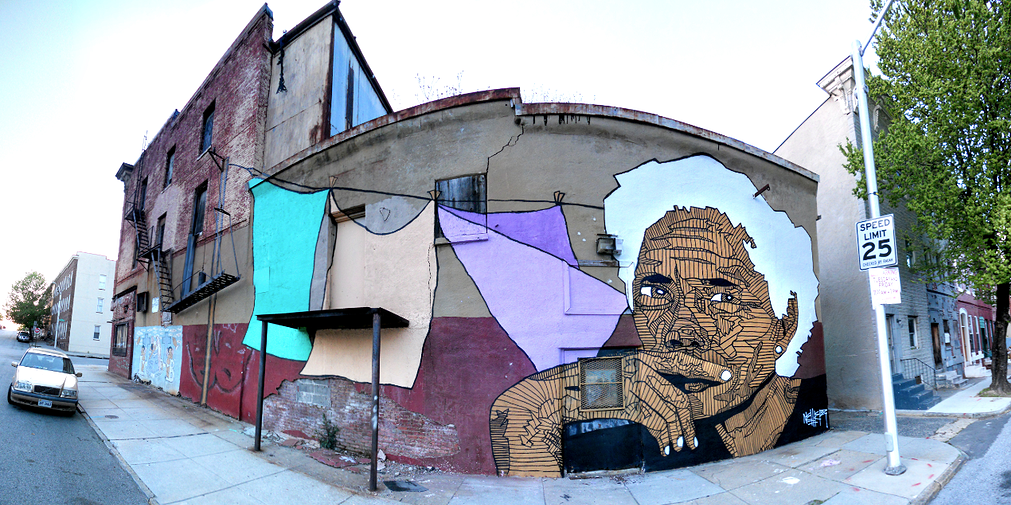Justin Nethercut, known more broadly as Nether, is a Baltimore born and based street artist driven by “vacant beautification, civil disobedience & tactical activism aimed at sparking dialogue on disdained urban issues.” Nether, who participated in Open Walls DC, believes that, “In a broken city, radical actions are needed to bring attention to ignored issues and tell forgotten histories. The pieces that you find around the city dignify and bring attention to ignored citizens and the forces that have brought the city to its shameful state.” Nether’s goal for his work is to solidify connections to and understanding of locations in the city that define Baltimore. His company, Wall Hunters Inc., has installed numerous murals on abandoned buildings in Baltimore.
After completing his Freddie Gray mural this spring, Nether kindly agreed to talk to BmoreArt about his process and ideas.
Cara Ober: Since 2010, you have created murals all over Baltimore and in other cities, too. Can you explain how murals and social justice are linked together for you?
Nether: Painting murals and working for social justice have always been intertwined for me, although I my interest in social justice began well before I found street art. I have been very interested in Baltimore and its social justice issues since I was a teenager. You cannot live in this city without seeing the stark differences in the living conditions and opportunities of its citizens based on race, education, and economic position, among other factors. While in high school, I went on a civil rights tour of the South and I participated in many of the protests organized by the Baltimore Algebra Project, especially about the underfunding of schools in ‘06 and ‘07. What I learned changed my outlook and deepened by interest in working for social justice.
I have always been into artwork in some way or another. At first I got into photography, video journalism, and mixed-media art but found myself frustrated with the Baltimore gallery scene because it seemed too staid and rarified to be able to communicate to the neighborhoods what my artwork was about. It was the citizens of Baltimore’s neighborhoods that were my real audience, not really the gallery goers.
Cara: How did you start doing murals?
Nether: When I was younger, I knew and was friends with quite a few graffiti artists from Adam Stab to CEDA and was fascinated by the impact of their work on the city’s landscape, but I never got really into graffiti myself besides creating stickers and putting up a few rollers. Around 2010, when I first learned about posting images with wheatpaste everything changed. I saw how wheatpasting relevant images in the neighborhoods I wanted to reach served to bring dignity, provide a voice for citizen outcries, and draw attention to these ignored parts of our city. Around this time, I became good buddies with TEFCON and then GAIA. I became absolutely obsessed with street art. I spent all my restaurant job earnings producing wheatpastes and putting them up any free night I had.
Cara: How would you describe your own painting style? What makes your murals different than many other artists?
Nether: Well, it begins with what I do before I wet a paint brush: I talk to neighbors in the place where I want to paint. It is though these conversations that I learn what will work and be meaningful to that community, whether sanctioned by city leaders and those who control property, or not. This bottom up approach of talking to people allows me to dive 10x deeper into the circumstances of the neighborhoods I’m painting about.
Artistically, I would say that my style has developed from my love for using small “hotdog” rollers on long poles. I really like painting from the ground or at a distance where I can see a greater area of the image at once. Developing this style has helped me learn to build the under painting and shading in my works. It also helps me save time and cuts costs when I am not getting paid much or am painting on vacants. I also use spray paint to sharpen things.
Cara: Can you tell me about the events that led up to creating the Freddie Gray mural on the corner of Mount and Presbury Streets? Do you see this mural as a collaboration with others from this community?
Nether: Well, over the years I’ve put up a ton of work in the the Penn-North, Sandtown, and Harlem Park areas. Early in the protests, I met the activist named Kinji Scott who introduced me to Brandon, Freddie Gray’s best friend and god-brother. This happened at the candle light vigil protest that occurred right after he died. Brandon is where everything really began. He knew my work and was totally into the idea of a mural. He completely took charge of the idea, worked collaboratively with me to design it, and managed every step of it from securing the reference images to the wall, to deciding who was included in the mural.
Cara: Why did you want to paint this mural? What did you want it to say to neighborhood residents and beyond?
Nether: I wanted to say the truth and the truth is that what people saw happen in Baltimore is the same damn thing that happened during the civil rights movement. This is a continuation of the same struggle to the same mountaintop that has been fought for decades. That should be obvious. The neighborhood stood up together on that Thursday and said enough is enough. By doing so they walked in the same footsteps as James Bevel, Martin Luther King, and all the giants who came before them. I was incredibly proud of this neighborhood and Baltimore for its courage and wanted to dignify the moment. Things did go wild here, for sure, but it hit us all in the heart and this city and all its pride and spirit took this new civil rights movement or whatever the media will decide to call it to the next level.
Cara: In your opinion, how can artists work together to improve the conditions of inequality in Baltimore? How does art translate across the boundaries that separate groups of people?
Nether: I see a lot of artist who are dead-on content. I mean you really just have to dive in. Street art isn’t the only way. Recently, I linked up with this amazing Baltimore City school teacher named Laura Emberson. She introduced me to teaching residencies at public schools available to community artists through Arts Every Day. Doing things like this, experiencing the eagerness with which school kids drink up art that reflects their own world, and just generally getting out there, opens you up to a whole lot of content that is both inspiring and very interesting artistically.
Although there are programs like Arts Every Day, most of the effort needs to come from the individual artist. It’s really time for young artists to step up and serve the community though their art. There is a disconnect between the arts community in Baltimore and the neighborhoods that the arts districts inhabit. This divide has almost intentionally been created by capital-driven developers, private institutions, and community associations that are staffed with individuals who are associated with developers more interested in the real estate than the people who live in the targeted area.
Ignoring the people who live there creates resentment and fosters further growth in the opportunity gap in our city. After all, neighborhoods have been trying to get resources from city leaders and those who control the purse strings for years—resources to address very real needs—and have been shut out. Then, the arts community moves in to their neighborhoods and public money starts flowing in just a few years. Essentially these forces have redesigned the fabric of existing neighborhoods and made “improvements” at the long term expense of the families that have lived there for generations and will soon be displaced.
ARTISTS HAVE POWER … EMPOWER OTHERS WITH THAT POWER.
IF YOU LOVE THIS CITY DON’T BE AFRAID TO CALL OTHERS OUT.
DON’T CONTAIN YOURSELVES.
STEP OUT OF THE BUBBLE CREATED FOR YOU.

